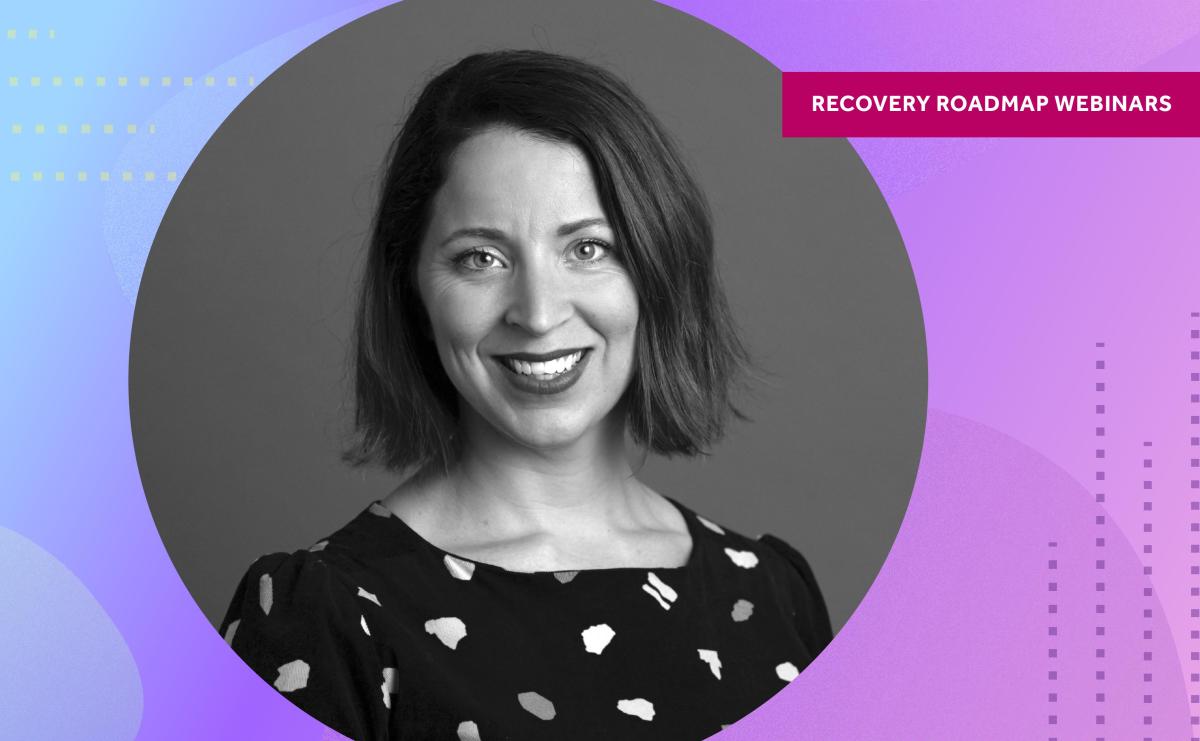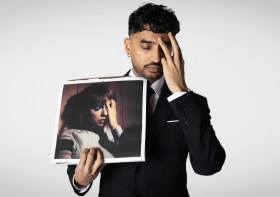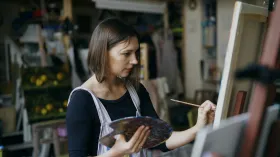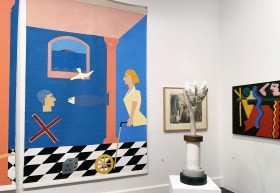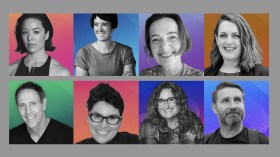When COVID-19 forced the closure of State Library Victoria shortly after the completion of a $90 million redevelopment of its physical space, one of the first things the Library team did was ‘really ask our audiences: what did they want from us?’ said Nerida Webster, Head of Brand and Audience Development at State Library Victoria.
‘It was already a really crowded digital space. People’s inboxes and newsfeeds were really being bombarded by programming and content and workshops and tasks, and we wanted to make sure that what we were delivering was relevant and responsive to our audiences,’ she explained.
‘[It is] incredibly powerful to just ask audiences what they want, what they need, what they expect. I can’t emphasise the power of that enough.’
Discovering that the real need was SLV’s core services – access to the collections, access to librarians, support for research and family history – Library staff focused on making that access easier.
Despite the crowded digital marketplace, they also increased digital communications with their audience, rather than decrease their output.
‘So our monthly newsletter became weekly under the umbrella of Library in Your Lounge, and we drove the message of “Keep exploring the world, keep exploring our collection, stay connected”. We did that across all of our touchpoints,’ Webster said.
Personalised communications, such as a video filmed by the CEO at home or in her backyard, have also proven useful: ‘You don’t need to have fancy editing or technology or video producers to really create authentic content that really connects with audiences.’
Webster also stressed the need to tell interesting stories in order to keep audiences engaged. ‘I think it’s about what’s relevant, what kind of is going on in the external environment that makes this timely and interesting, and how are you creating that kind of narrative and also those personal potential exclusive experiences,’ she said.
Another tip was not to be shy about filming a video or hosting a Zoom Q & A or related event from home. You may not have had a haircut for months, but so what?
‘Don’t be shy. Just try it. We’re all nervous. Put it out there and I think you’ll find audiences are quite responsive and generous and will tell you again what they need as well,’ Webster urged.
The fourth and final Recovery Roadmap Webinar, focused on maintaining mental health during COVID and featuring the Arts Wellbeing Collective’s Kirsty Ritchie, takes place on Wednesday 23 September at 1pm AEST. Bookings are essential although tickets are free.
WEBINAR Transcript provided by The Captioning Studio
RUTH GORMLEY: Good afternoon, everyone. While we are currently all in different locations, I would like to begin by acknowledging the traditional owners of the lands on which we live and work. I pay my respects to their Elders past and present and to any Elders who may be joining us today.
I am Ruth Gormley. I lead the Strategic Marketing team at Creative Victoria and my preferred pronouns are she/her. I want to welcome you all to this third Recovery Roadmap webinar, Communication in COVID and Beyond with Nerida Webster. Creative Victoria is really enjoying working with ArtsHub on presenting these webinars as part of our Creative Exchange program. We hope you’re finding them useful and interesting.
On the housekeeping front, this webinar is being live captioned. If you want to see the captions, just follow the link in the chat. You will need to be using Google Chrome. We are also recording this session, meaning any questions you ask will be on record. The recorded webinar will be available through ArtsHub and the Creative Exchange page on the Creative Victoria website. We’ll be sending out a survey following the webinar, so please fill that in to let us know how we’ve gone and what you would like to see covered in future.
I’m not sure if Richard Watts is here yet. ArtsHub, are you able to let us know what’s happening now? I think I’m supposed to fill the dead air for a moment or two, which is awkward because I don’t have a great deal more to say.
Nerida is the head of marketing and comms for – Nerida will give you her title at State Library Victoria, and I see Richard. I have muttered enough. I’ll pass over to Richard Watts. Have a lovely time. Enjoy the session.
[Technical difficulties: no audio]
NERIDA: Hi there, everybody. Very interesting that we’re having technical difficulties because it’s one of the things I’m going to talk about when we’re talking about communicating during COVID – and one of the things I say is that audiences are very generous, and the tolerance of dealing with technical issues while we’re going through these things is we’ve seen it to be quite high.
Although I believe Richard is back. So if you do want to jump in, Richard, before I kick off, please do while I bring up my presentation and then we’ll see if you want to jump in.
OK, well, I might just kick straight off and hopefully you can see my presentation. So I have been asked here to talk to you about communication in COVID and beyond and engaging with audiences, and I’m really grateful to have the opportunity to talk to you about some of the things we’ve been doing at State Library Victoria.
I’m the Head of Brand and Audience Development there, which I think, Ruth, is just a fancy way of saying ‘head of marketing and comms’. So my wonderful team leads the Library’s marketing, corporate communications, public relations, media, social media, website and everything that goes with that. So we’ve been pretty critical to people continuing to connect with the Library during COVID, when the Library’s actually closed.
Before I talk to you about what we’ve been doing during COVID, I just wanted to give you a little bit of context around what we were experiencing leading up to COVID. Some of you probably know that the library was going through a major redevelopment in the years leading up to COVID. It was actually a five-year project. That was $90 million. It was really all about transforming the physical building of the Library. That’s something we’d been talking to our audiences about for five years. We’d raised $30 million on the promise of this physical transformation, and in December last year, we re-opened all of our new spaces, with the exception of one.
So that was our grand opening and we were going into 2020 talking about the extraordinary spaces that people could now experience at the Library. We had a campaign, a major marketing campaign, in market, telling people “Come to the Library”. You can see on the screen some of the creative from that campaign, which was all about “New spaces now open. Just add curiosity”.
We were seeing 7,000 visitors a day through our doors, which was just astronomical at a time that is actually traditionally a quieter time of the year in January, and that’s up from around 5,000 that we would normally see before we transformed these spaces.
The final space that we opened was called Start Space, which is a dedicated co-working collaborative space for early stage entrepreneurs, and we opened that space on Friday the 13th of March, and three days later, the Library closed because of COVID. So that might be a lesson in launching things on a Friday the 13th.
So COVID hits. What did we do? One of the first things that we did was really ask our audiences: what did they want from us?
One of the first things that we did was really ask our audiences: what did they want from us?
It was already a really crowded digital space. People’s inboxes and newsfeeds were really being bombarded by programming and content and workshops and tasks, and we wanted to make sure that what we were delivering was relevant and responsive to our audiences. So we put something out through our newsletters.
We created an online form on our website but, equally, you could do something like use the Survey Monkey platform. You could even just do a poll on social media. It’s really low cost or no cost but incredibly powerful to just ask audiences what they want, what they need, what they expect. I can’t emphasise the power of that enough.
What we heard was really interesting. Audiences, and I guess it shouldn’t have been surprising but it was really about our core services. They wanted things that they could only get from the Library that they couldn’t get anywhere else. So it was about access to our collections, access to our librarians, support for research, support for family history.
So very early on, the first thing we were focused on is how do we increase that access and make it much easier for people to become a Library member and engage with our collections?
So we did things like simplify the sign-up process. We made it so that people could get immediate access to collections, which seems sort of hard to believe now, but before COVID, it wasn’t an immediate activation of membership.
We negotiated with vendors, third party vendors that we have relationships with, to supply databases, things like Ancestry.com, which previously you could only access for free from inside the Library building but now our library members during COVID are able to access that for free from home.
We also negotiated things like increasing our e-bookshelf offering, and again that’s with a third-party vendor we have a partnership with, and they increased our e-book offering from I think about 20,000 to 200,000 e-books available, and that’s been hugely popular. We’ve also now recently just introduced a live chat with our librarians, so people can chat with our librarians [in] real time. I think some of these things were absolutely in the pipeline but COVID has made us very quickly, rapidly, bring these to market now.
The other thing we did was we increased the frequency of our communications with our audiences, so our monthly newsletter became weekly under the umbrella of Library in Your Lounge, and we drove the message of “Keep exploring the world, keep exploring our collection, stay connected”. We did that across all of our touchpoints.
Our newsletters for our Friends of the Library, which is our paid membership program, also increased from quarterly to weekly, using the same weekly newsletter we had, but every month there would be exclusive content in there for Friends only, and exclusive online talks for our Friends membership base as well.
We also introduced videos from our CEO each week in our newsletter, which was a little intro around what they can expect from the Library this week, and that’s really Kate at home – Kate Torney, our CEO – filming that on her iPhone in her lounge room or from her backyard and it’s really added a personalised connection with our audiences. So you don’t need to have fancy editing or technology or video producers to really create authentic content that really connects with audiences, and we found that that again has really resonated and people are viewing that when they open our newsletters.
We are also really lucky to have a resource on staff that is a video producer, so we’re able to also create a huge amount of content that actually takes audiences back into the Library at a time when they can’t access the Library. So we have been creating two to three minute videos that really take people behind the scenes but also show kind of gems of the Library and things that are sort of hidden in plain sight, things like you may have seen some of these but the furniture in the Library’s dome, people would walk past that every day but that’s actually the original furniture, so having a little story about that in our channels is really valuable.
I have put on the screen there you can see some feedback from an audience member that has contacted us to tell us what they’re getting out of what we’re sharing, and I really, just that bottom sentence that says, “Though I visited the Library in the days when that was possible and joined a Library tour, these are offering so much more”. So it’s actually presented an opportunity for us to kind of engage in a different way with our audiences, and the feedback we’re getting is that it is absolutely resonating at the moment.
Again, even if you don’t have access to a video producer who’s got amazing equipment, a mobile phone and a great story is just as powerful. So I would encourage you absolutely, if the story is engaging, the polish – especially in a time of COVID – is not the expectation of audiences necessarily at the moment, and especially in platforms like social media.
‘Even if you don’t have access to a video producer who’s got amazing equipment, a mobile phone and a great story is just as powerful.’
Our programming team obviously also have been very focused on creating and delivering programs. They’ve done this quite rapidly, trying to see what resonates, what works and adapting as they go.
As I said at the beginning, I think audience expectations around production quality have been quite generous, and the world over we’ve got high profile journalists and actors and authors and musicians sitting in their lounge room or their kitchen and connecting with audiences, and there’s been a real charm to that. I think again it sort of reinforces that feeling that we are actually all in this together, and so I think again don’t be afraid to try things.
So we’ve had our family programmers out telling stories and singing songs to our children audiences from their lounge room. We have had our librarians producing content and telling stories through a YouTube video series we have produced called Ask A Librarian, and that Ask A Librarian series is one of our most popular content pieces, and it’s being produced by the librarians themselves using the technology that they feel most comfortable with.
So some of those people are using, some of them are using Zoom and recording themselves talking to camera and showing, sharing their screen. Some are using Powerpoint and doing a voiceover and recording that. Some are using iMovie. So there’s varying outputs that are coming but it’s really about what they’re confident in using, and what we’re seeing again is it doesn’t matter if it’s not highly polished or edited as professionally as perhaps we were doing before COVID.
Again, it’s about creating content that’s engaging for the audience. You can check them out on YouTube and I think there is a link to our YouTube channel in the chat if you want to go and have a look there. Really again it goes back to the fact about what is the content that our audiences want from us that’s relevant and it’s about what is unique to the Library. So that’s what we’ve been really focused on creating and pushing out.
So the other thing I wanted to briefly touch on is the Library also had obviously a critical role to play in collecting. We’re a collecting institution so that future generations can look at the way we lived and things that went on today and the kinds of experiences that we were having. So our collection teams have been out documenting, collecting, literally taking photographs of playgrounds with signs closed like this one. But this was not taken by a librarian. This was taken by a member of the community who has contributed to something we’ve created which is called Memory Bank, the Collective Isolation Project. Again, we’ll pop a link to this in the chat.
But what we wanted to do was to create a space for community contributions and for the community to come together, share their experiences and reflect, I guess, on what’s been happening but also to become what we’ve called Citizen Collectors. It’s about how all of these contributions can be shared with the Library so that our collection is richer, and the perspectives are from across the whole of Victoria and not just Melbourne and things like that, that they’re really coming through in what we’re collecting.
So people are sharing lots of content in there, but we also each week have been posing questions and prompts to help generate the sort of content we also do want to capture. So for the first week, for example, it was: ‘Take a photo of what’s in your fridge, tell us what’s in there,’ which might seem completely strange and bizarre now, but in 50 years’ time, somebody looking at the contents of our fridge is actually really interesting and tells a story about the way we live today.
We’ve had over 2,000 members to that and we’re getting contributions every day. Some of it is in response to the specific questions we’re asking and some of it is just people contributing what they’re doing on their walk, the things that they’ve been doing at home, what are the new skills they’re learning, and you can go and have a look and explore some of the discussions in that forum.
So, just quickly, some of the things that we have achieved: we have had more than 2.7 million user sessions since we closed in March on the Library website, which is an increase of 25%.
The number of people using the Library’s catalogue has increased by 20%.
Use of our licenced databases, so things like Ancestry.com is up 172%. So if anybody is out there doing their family history, you’re not alone.
Our librarians have answered more than 3,500 reference and research inquiries since closure, so an increase of 65%.
We have seen an increase on our social channels of around 8,000. So it’s been really interesting to watch the way audiences have connected and responded to what we have been creating.
We have had more than 2.7 million user sessions since we closed in March on the Library website, which is an increase of 25%.
So what are the things that we have learnt and what does this look like moving forward?
Well, I think, like many others, I am sure it’s forced us to adapt very quickly to bring things that we were thinking about to reality in a much shorter space of time and to test what we’ve been doing, and I guess in a COVID normal or a post COVID world, there is absolutely no doubt about it, we will continue to have a strong digital offering and a hybrid offering of that physical and digital experience.
I guess some of the things that we will need to explore and question and discuss over time is: what’s the balance between the physical and the digital? What are we creating that’s complementing experiences and not just replicating them? How do we keep listening to audiences and understanding what their needs are and how are they going to change, because I think we don’t know that. We don’t know how audiences are going to behave. I don’t think individuals necessarily know that, as we are looking at coming out of lockdown. But I think asking is always incredibly valuable.
I think also looking at what other research is being done. So the Audience Outlook Monitor research by Patternmakers, which I am not sure if you are familiar with sorry. Excuse me. That is also incredibly valuable, and I think we could probably put a link into the chat there as well. But just try things I think is my main message, and test and listen.
RICHARD: OK. Speaking of listening, Nerida, can you hear me?
NERIDA: I can hear you. Can you see me?
RICHARD: I can. Fantastic. Ladies and gentlemen, I do apologise for the technical drama that we had at the start of the session. For those of you who don’t know me, hello, Richard Watts from ArtsHub. Everything was working perfectly half an hour ago.
Nerida, to pick up on one of the points you made, you said if a story is engaging, you don’t need polish in your social and digital presentations. What makes an engaging story? What can other organisations seize upon within their own organisation, their own ranks, to make an engaging story at this time?
NERIDA: Look, for us I think it’s absolutely about what are the things – it’s not necessarily COVID that’s made this an engaging story, but the things that we know resonate with our audiences is that behind the scenes, those kind of coming into – and I guess what might feel like an exclusive or intimate experience, or how are you kind of telling a story that is surprising or interesting or quirky?
We’re very fortunate at the Library to have an incredible collection where you can kind of dive in anywhere and start to draw out some of those things.
I think, as well, looking at relevance and what’s going on, so kind of early on, some of the first things we were bringing out were, our librarians put together pretty incredible research guides and things that kind of delve into stories in our collection. We did one on the Spanish flu because it was this lived experience that Melbourne and Victoria have been through before, obviously in incredibly different circumstances, but that was one of the only other times the Library has closed its doors, during the Spanish flu. But this has now been the longest.
But I think it’s about what’s relevant, what kind of is going on in the external environment that makes this timely and interesting, and how are you creating that kind of narrative and also those personal potential exclusive experiences.
RICHARD: Can you discuss any examples you’ve observed of successful models of digital engagement from other organisations, especially smaller organisations during this period?
NERIDA: Look, I mean, I think one of the things it’s been really interesting and I’m going to draw on my husband actually because we’ve now been working in close quarters and he works for an organisation called Support Act, which you may or may not have heard of, but it’s a mental health organisation, crisis relief for the music industry. Obviously, they’ve been incredibly impacted, the music industry, and so one of the things they did very early on was quickly create a lunchtime video series which was absolutely about, it was a Zoom call. It was talking to another professional and it was about how the hell do we deal with this, and again that was relevant, relevant content for their audience because everybody was grappling, and so they didn’t kind of plan and map that in any in depth way. They just saw a need and used the platform and the opportunity that we’ve got in COVID to just kind of put it out there in this almost beta style, and that has really resonated and continued throughout COVID.
Read: What will post-pandemic audiences look like?
RICHARD: Now, earlier – some questions now that are coming in via the Q&A function. Earlier you mentioned a crowded digital space, but nonetheless you’ve increased your e communications. How did you navigate the tension between that?
NERIDA: I think again it really goes back to understanding what was important for our audience and what was unique to us. I think early on, we saw so many so much content being produced and so much “try this baking” or “do this activity”, and I think one of the things when we went out and asked our audiences what they wanted, we kind of went out with this message of we’re creating a clearing space in the cyber noise for you to tell us what you need from us, and we really honed in on: well, it’s actually about making sure our collection was accessible and our librarians were accessible to help people navigate that in interesting ways and tell those stories that were unique to us, so trying not to compete with what was going on and talk directly to our audience.
RICHARD: Another question that’s come in live over the Q&A, somebody says “I am shy about doing regular videos from my office on COVID. I don’t have make up on, don’t have my hair done. Is that a problem?” I would imagine that there is something very personal and very real about, whether it’s somebody’s headset not working in a situation or the presentation from the home office?
NERIDA: I absolutely think that is correct. I feel there’s this real charm or one on one intimate experience you feel like you’re having when we’re all sitting in our lounge room, or you see the kids pop up, or the dog pop up, and it kind of just makes me think back to BBC Dad, I don’t know if anybody remembers that video?
He was doing what we’re all doing now, where his kids are kind of storming in and he’s doing it on international news, but I think there’s almost – I feel like there’s such generosity amongst audiences and with people that are doing, especially livestreams – I feel that there is an intimacy about that that is adding value to the experience.
So don’t be shy. Just try it. We’re all nervous. Put it out there and I think you’ll find audiences are quite responsive and generous and will tell you again what they need as well.
RICHARD: Alright. We’ll going to run five minutes over time, just to make up for the technical difficulties earlier. And another question, Nerida. In terms of challenges and successes that State Library Victoria has had in engaging and encouraging audiences who may not have been particularly digitally savvy or tech savvy before.
NERIDA: That’s interesting. That was an issue for us internally as well. We have a really wide ranging group of people that work for the State Library, and particularly, looking at our librarians sitting in front of a computer and recording themselves talking about it, it was totally pushing the comfort zone and they’ve done an extraordinary job to do that. Some of our colleagues didn’t even have, didn’t actually have any technology at home and how we’ve worked with them to do that. I think we’ve all been on a learning curve together, I think.
To be honest, I’d never even heard of Zoom before COVID and I think that what we’re finding is people are supporting each other, developing those skills.
I think for us, it is a really challenging thing, how you create access for people when they are, when there is a digital disconnect there and a digital divide, and that’s why having things like – people can still call the library and there’s a recorded message when our librarians are coming back, people can still email the library and they’re responding to communications in that way.
But I think again, audiences have shifted and we’ve kind of all been forced to develop our skills in this area and again people are quite generous in building that up.
RICHARD: Now, communications can’t be perfect at this time. Have you outsourced communications at all and, if so, have you been agile in collaborating?
NERIDA: I missed the start of that. You broke up a little bit, Richard.
RICHARD: In terms of accepting the communications may not be perfect, have you outsourced any of those at this period and tell us about the collaboration, if that was the case?
NERIDA: Well, we’re quite fortunate have to – I’ve got a pretty good team internally and so we haven’t had to outsource the work we’ve done in the comms space or in the programming space, although we have engaged from a programming perspective, we’ve engaged some key talent and that’s helped develop some of those.
Astrid Edwards for example, you may know, who’s been hosting our afternoon tea and talks with authors, and that’s been a great collaboration and she’s a great friend of the Library.
Tai Snaith is somebody else we’ve been developing programs with, and so really aligning with that great talent we had relationships with before but we have been working and adapting with them in a COVID environment.
I think we have moved very quickly and I think internally – I guess the collaboration internally has probably been quite challenging in a working-from-home environment because there are reasonable sized teams and a lot of content being produced and so working together across all the new platforms we were using – we introduced Microsoft teams during COVID and things like that. So navigating all of that has been challenging and I think managing expectations around time lines and things – because we’ve been doing that in an incredibly rapid environment – but equally, I know other organisations and smaller organisations have outsourced things like technology to be able to deliver some of the livestreamed programs and I know that was talked about last week on this session.
So I think it’s about knowing where the strengths are and the opportunities and collaborating where it makes sense.
Read: Reaching new audiences in a time of crisis
RICHARD: Thinking about the future, how do you think COVID 19 has changed communications and how will you adapt to those changes in the future?
NERIDA: I think again people’s expectations have shifted a little bit. I don’t know that the frequency that we’re communicating now will continue at that same frequency as we start to come out of lockdown, but I think that will depend on audiences and we’ll ask more questions to help inform that.
But I think again there’s this expectation that we have this more intimate personalised experience because we have been putting that out there. We have been taking videos on our iPhones and sharing that content, and there’s a bit more, I guess, realtime nature to some of the stuff that we’re doing. So I think there’s some real benefits to that.
I think the access that the increased access, not just in terms of to our collections but the reach across people from regional areas and people who might have access issues or be living with a disability, those things – I think COVID has really changed the game for them and created real opportunities. So those are the benefits that we will make sure we are continuing to build into what we deliver.
RICHARD: And as a last question, have you employed new team members who can specifically work with the digital platforms of Zoom and create new content for the State Library’s website at the moment, and, if you have, what kind of skills do those people need?
NERIDA: Well, we have actually been recruiting, and we were actually already recruiting before COVID hit but we have increased the number of roles that we’ve recruited to be able to support the output of work that we’re producing. We’ve got new producers in our programming team and absolutely thinking about their skills in a digital program production sense versus a traditional onsite experience has been a factor in that. And we’re also in the process of actually recruiting some more technical operations staff.
So we’ve got an amazing colleague, Richard, who’s kind of our go to guru when it comes to our livestream events and things, and he traditionally was working with our commercial clients – the Library is a space where you can hire venues. Obviously, that’s not happening at the moment and so Richard has absolutely been supporting the program delivery as we’ve been going through. But he’s one person, so we’re building the skills in that space.
So things like putting Zoom on speaker view and having, managing that chat function and changing the screens that people are seeing so it’s feeling like more a smoother kind of realtime edit of a program as opposed to kind of just one head talking. So he’s been amazing and we need to build that capability and bring in more of those skills.
The other skills we’ve been bringing in is again more content producers for our website – and it’s copywriting skills, it’s knowing the key message you want to drive. Our social media team, we’ve got an extraordinary social media coordinator but she’s one person as well, so we’re recruiting in there.
So absolutely we’re recruiting. And it’s about, it’s those technical skills, it’s writing, it’s knowing what the message should be.
RICHARD: Great. On that note, Nerida, we have run out of time. Thank you very much not only for chatting with us today but also jumping in as an emergency when my computer just decided not to cooperate. If you would like to share today’s discussion, video, a full transcript, et cetera, will be available on ArtsHub by Friday. And next Wednesday, at the same time, 1pm Australian eastern standard time, we’ll be presenting our final webinar in this series: Mental Health Advisory. I hope you can join us then. Thanks for sticking with us. We’ll catch you next week. Bye bye.

